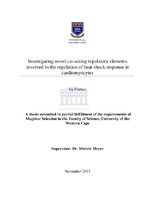Investigating novel cis-acting regulatory elements involved in the regulation of heat shock response in cardiomyocytes
Abstract
Ischemic heart disease is a disease which is characterized by the reduced blood
supply to the heart. According to WHO 2013, ischemic heart disease is one of the
major causes of death globally. For this reason, it is imperative to search for
methods whereby heart cells can be protected from cell death. The upregulation
of heat shock proteins (Hsps) is one of the major techniques which can be used to
protect the heart cells from Hsps cell death and improve the tolerance to ischemic
stresses in various models. The increased expression of Hsps during heat shock
pre-conditioning is regulated by heat shock transcription factors (HSFs). HSFs
orchestrate the initiation of gene expression by binding to sequence motifs, known
as cis-acting regulatory elements (CAREs). Since gene expression is regulated at a
transcriptional level, it is expected that functionally related genes (e.g. heat shock
response genes) might also be regulated by the same transcription factors (TFs).
In this study an in silico approach was performed to identify the promoter sequences of 50 known heat shock responsive genes using Genomatix Software.
This software was also used to identify transcription factor binding sites that are
statistically over represented in the promoter sequences of these genes. The use of
the Electrophoretic Mobility Shift Assay was included to confirm that protein cell
lysates of stressed cells contain proteins (TFs) that bind to this sequence
(SP1F_KLFS_01). Luciferase promoter reporter assay were also used to iii investigate the transcriptional activity of mutant promoter constructs in which the
SP1F_KLFS_01 was mutated. SP1F_KLFS_01 is a ±25 base pair sequence that was identified in the promoter sequences of 19 heat shock responsive genes, including the well-known Hsp70 and Hsp90. This sequence is a potential binding site for two TFs, Specificity Protein-1 and Krueppel like TFs. Consequently, the aim of this study is to identify CAREs that are statistically over-represented in the promoter regions of heat shock response genes. In conclusion, in vitro experiments of this study did not support the findings of the in silico experiments, therefore additional methods should be implemented to expand the investigation for the involvement of cis-acting regulatory elements in the regulation of heat shock proteins in cardiomyocytes, prior to heat shock.

